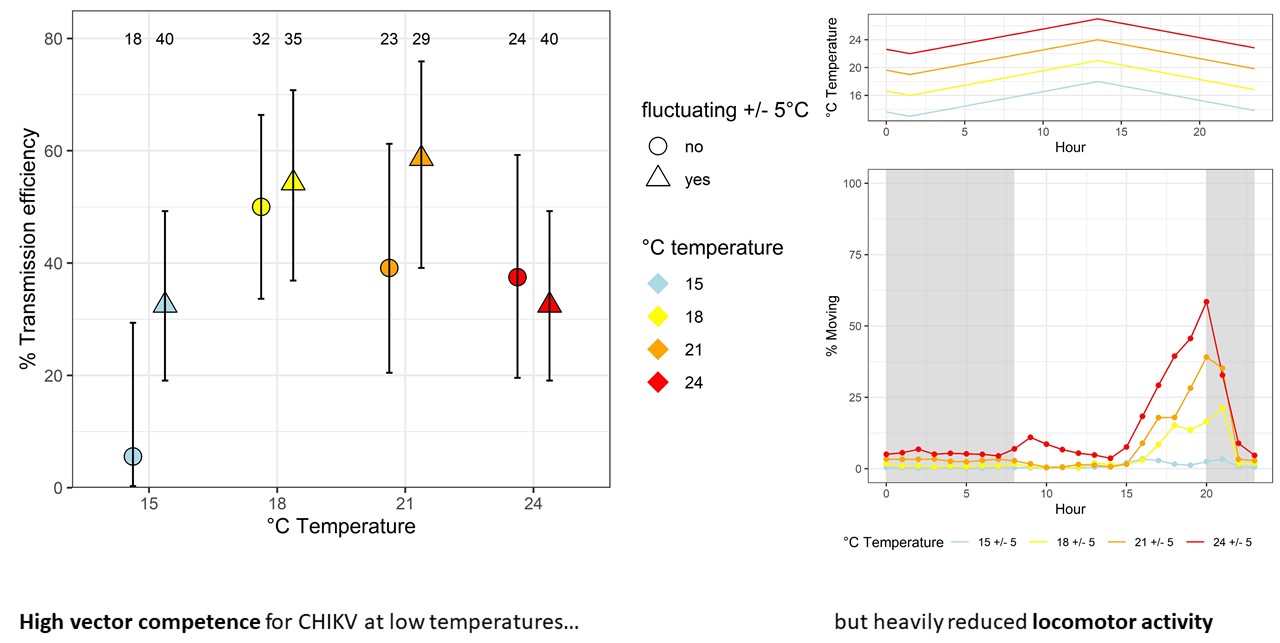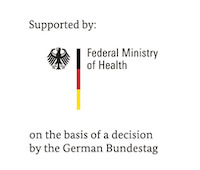How tiger mosquito activity affects the risk of chikungunya transmission in Europe
Researchers at the Bernhard Nocht Institute for Tropical Medicine (BNITM) have investigated how the Asian tiger mosquito transmits the chikungunya virus under different temperature conditions. The study shows that the virus can replicate in mosquitoes at temperatures as low as 15°C. However, the mosquito hardly flies at this low temperature, which significantly reduces the actual risk of infection. The results have recently been published in the journal Parasites & Vectors.
![[Translate to English:] Asiatische Tigermücke (Aedes albopictus) Blutmahlzeit [Translate to English:] Eine Asiatische Tigermücke sitzt auf einem mit Blut getränktem Wattestäbchen und nimmt eine Blutmahlzeit ein.](/fileadmin/_processed_/4/5/csm_BM-im-Lab_Aedes_albopictus_4_2656cf0ade.jpg)
The chikungunya virus belongs to the togaviridae family and is transmitted by mosquitoes of the Aedes genus. Infected people often suffer from sudden onset of fever and severe joint pain, which in some cases can last for months or years. The virus is endemic in tropical and subtropical regions. It is on the rise in Europe as a result of international travel and the spread of invasive mosquito species such as the Asian tiger mosquito (Aedes albopictus). In recent years, there have been several outbreaks of chikungunya in Italy and France, with hundreds of people infected.
In laboratory experiments, the team led by Dr Anna Heitmann, laboratory group leader at BNITM, infected Asian tiger mosquitoes with the chikungunya virus. Under controlled conditions, the researchers tested how well the mosquitoes could transmit the virus at different temperatures. They used innovative methods to observe the activity patterns of the tiger mosquito: They used precise temperature chambers to simulate realistic day-night fluctuations, and monitored the mosquitoes' movements with highly sensitive motion detectors. After 14 days – enough time for the virus to replicate in the mosquito's body and enter its salivary glands – the scientists tested the mosquitoes for infection: among other things, they tested the mosquitoes' saliva for infectious virus particles. This allowed them to analyse in detail both the biological development of the virus and the behaviour of the mosquitoes.
Combination of vector competence and activity key to risk assessment

Aedes albopictus was able to transmit chikungunya virus under all conditions tested. The researchers measured the highest transmission rates at fluctuating temperatures of 18°C (54.3%) and 21°C (58.6%). However, the tiger mosquito was also biologically capable of transmitting the virus at temperatures as low as 15°C – although the mosquito remained almost completely inactive.
"Our experiments showed that the activity of the mosquito plays a key role. Even if the virus can replicate in the mosquito in a cool environment, the risk of virus transmission remains low as long as the mosquito flies infrequently and has little contact with humans," explains Dr Renke Lühken, first author of the study and head of the BMBF junior research group Arbovirus Ecology at the BNITM.

An analysis of climate data showed that regions in southern and central Europe – such as France, Italy and some parts of Germany – are climatically suitable for chikungunya virus transmission. However, the reduced activity of mosquitoes at lower temperatures significantly reduces the actual risk.
"Temperatures not only affect virus development in the mosquito, but also how active the mosquito is. Our study highlights the importance of not only analysing vector competence, i.e. the ability of mosquitoes to transmit the virus. We also need to include ecology – the interaction of mosquitoes with the environment – in the risk assessment. If we consider these factors together, we can better estimate the risk of virus transmission," says Heitmann.

Contact person
Dr Anna Heitmann
Research Group Leader
Phone : +49 40 285380-832
Email : heitmann@bnitm.de
Dr Renke Lühken
Group Leader Arbovirology Ecology
Phone : +49 40 285380-862
Email : luehken@bnitm.de
Dr Anna Hein
Public Relations
Phone : +49 40 285380-269
Email : presse@bnitm.de
Further information







